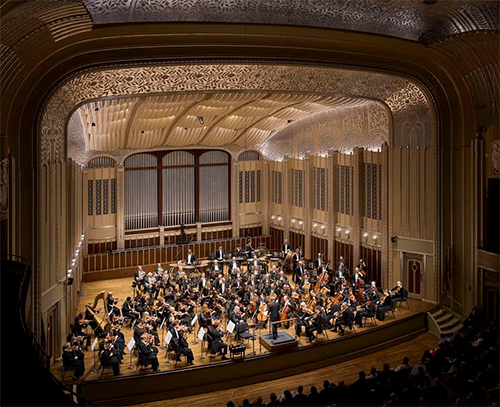by Kevin McLaughlin
This article was originally published on Cleveland.com
Photo by Roger Mastroianni

Snouffer walked onto the stage cautiously — as if unsure she should be there at all — at about the three-quarter mark to deliver a series of musically angular but disarming lines about celebrating the joy of one’s experiences.
A Cleveland Orchestra co-commission, “Ces belles années…” also contains hidden allusions to the classic “Happy Birthday” tune as a nod to Jolas’s beloved Aix-en-Provence Festival, which celebrated its 75th anniversary in 2022. In a recent interview, the 97-year-old composer said, “I’ve retained the profile of the famous tune without the notes but sometimes you recognize it. Then I tried to evoke my memories of Mozart operas and the idea came that I should have a soprano voice at the end. I call this voice ‘Messenger Angel.’ She comes in to call everybody to celebrate, saying ‘You will also come (in French: Et toi, le tout petit, tu viendras aussi).’”
Written for a large orchestra with a well-stocked percussion section comprised of only the merriest of instruments — tom-toms, wood blocks, maracas, bongos — the work opens with lots of thumps and rattles before the rest of the orchestra is drawn into the fun. There are salvos of atonal string and brass passages, mostly in short, jazz-like syncopations which are further interrupted by plops, bangs, and crunches from the percussion. Susceptible to the Messenger’s infectious enthusiasm, a series of unorthodox noises from the players ensues (whispering, clapping and stomping of feet) before everyone — singer, orchestra, and conductor alike‚ succumbs to peals of laughter.
Conductor Daniel Harding has become a regular with the Cleveland Orchestra, but I don’t remember ever being as bowled over by the level of precision and control he displayed as I was on Thursday night. There was not a single rhythmic, tempo or timbral choice that he hadn’t given some thought to. Not to say that his choices were stale or inert, only that the musicians had no reason to doubt them. It is always thrilling to be led by someone with such a clear understanding of his task.
In the Mahler, ensemble playing was unstintingly strong and precise. Individual contributions, particularly concertmaster David Radzynski’s scordatura solos in the scherzo that symbolize the medieval “Freund Hein” (personification of death), were outstanding. Frank Rosenwein’s oboe playing, whether in combination with other players or by himself, was also uniformly excellent. Nathanial Silberschlag played every horn solo as it ought to be played in Mahler — clean and true, with heroic boldness.
There was an especially fine moment in the third movement (this may be Mahler’s most beautiful adagio), where three solo sounds — oboe, English horn, and horn — intersected for a passage of extraordinary transparency and beauty.
Soprano Lauren Snouffer brought a demure, radiant sweetness to the finale’s childlike vision of heaven.
Published on ClevelandClassical.com December 5, 2023
Click here for a printable copy of this article



